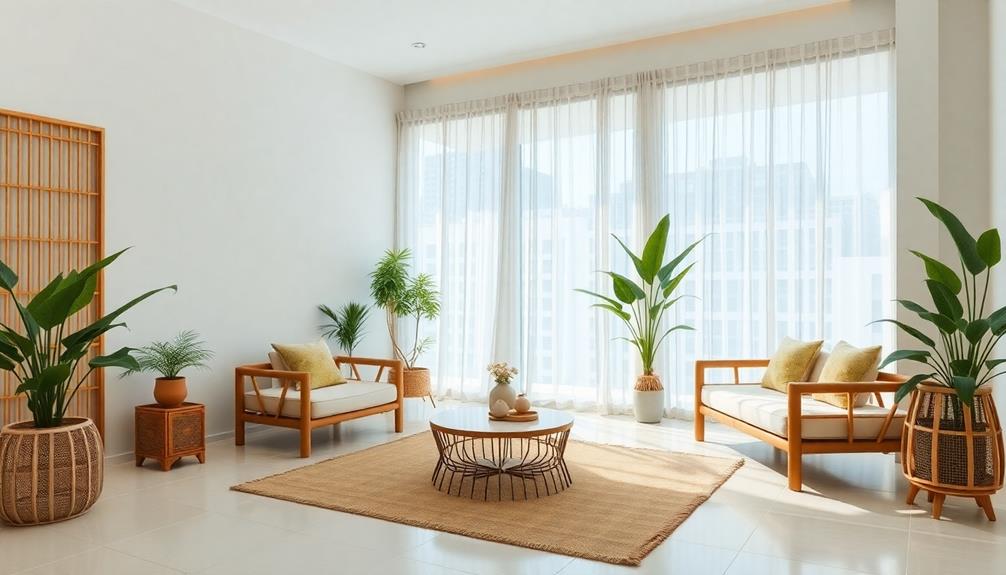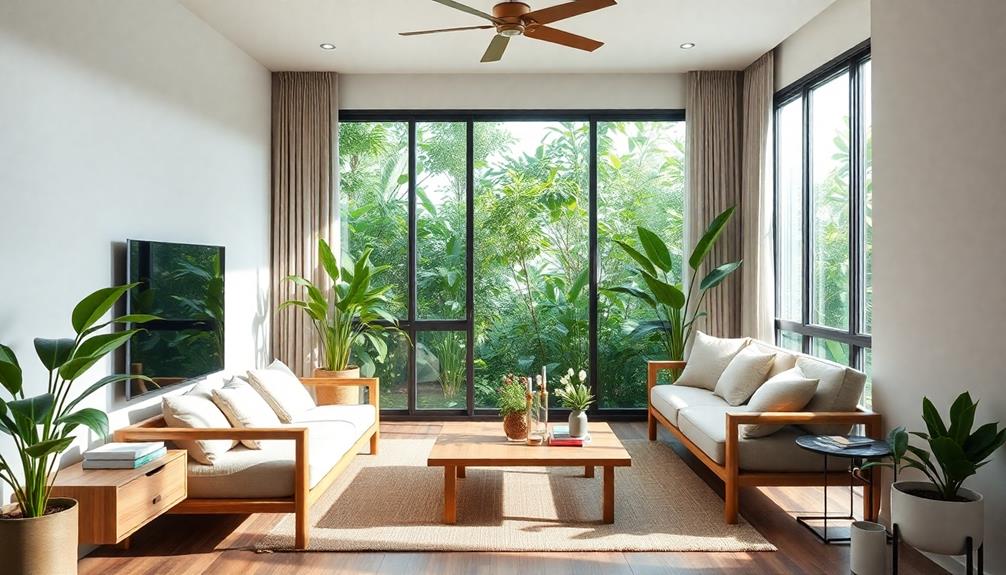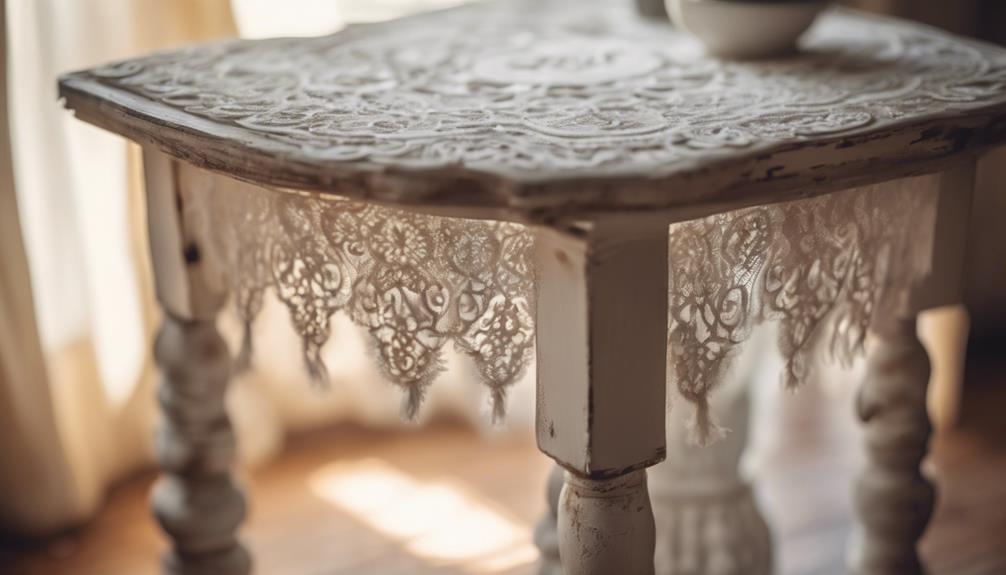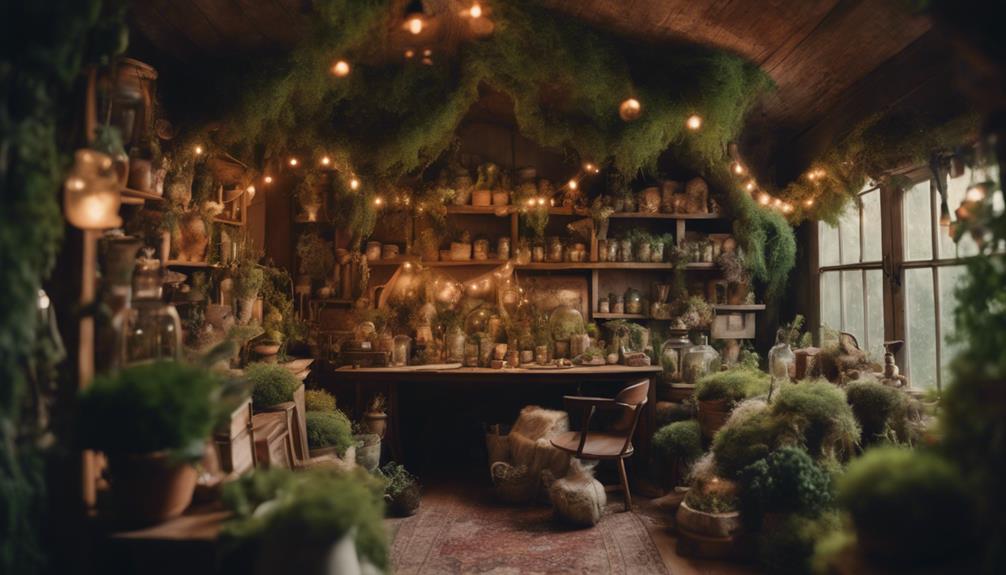Minimalist Indonesian design ideas for small spaces emphasize simplicity and functionality. You can enhance your area using multi-functional furniture, like an ottoman with hidden storage or a sofa bed. Embrace open layouts to maximize natural light and airflow. Incorporating local materials, like bamboo and teak, connects your home with nature while providing a serene atmosphere. Choose bright or neutral color palettes to create a spacious feel and add life with indoor plants and minimal decor. This approach makes your space inviting and organized. There's plenty more to explore about how these elements can transform your small space into a tranquil retreat.
Key Takeaways
- Utilize multi-functional furniture, such as storage ottomans and extendable tables, to maximize space efficiency in small Indonesian-inspired interiors.
- Incorporate natural materials like bamboo and teak to create a serene atmosphere while promoting sustainability and authenticity in design.
- Embrace open-concept layouts to enhance airflow and natural light, making compact areas feel larger and more inviting.
- Use a neutral color palette with bright accents to maintain a clean, spacious look while allowing for cultural decorative elements.
- Add greenery and traditional Indonesian textiles as impactful decor that brings warmth and cultural richness without cluttering the space.
Innovative Tiny Villa Concepts

When it comes to innovative tiny villa concepts, the Putih Tiny Villa in Bali stands out as a prime example of modern architecture that maximizes small spaces.
Designed by Balitecture, this villa showcases a flexible layout that effortlessly merges indoor and outdoor areas, enhancing your living experience in a tropical climate.
The house design emphasizes local materials and craftsmanship, creating an aesthetic that harmonizes with Bali's stunning landscapes and rich culture.
This design approach reflects the principles of Balinese Interior Design and Decor, which prioritize natural materials and an open floor plan.
Incorporating eco-friendly practices, the interior design promotes natural ventilation and light, which not only elevates energy efficiency but also fosters a serene atmosphere.
This approach is typical of small tropical house designs in Indonesia, where comfort and sustainability go hand in hand.
Each space within the villa is expertly crafted to serve multiple functions, ensuring practicality without sacrificing style.
Affordable Small Space Solutions
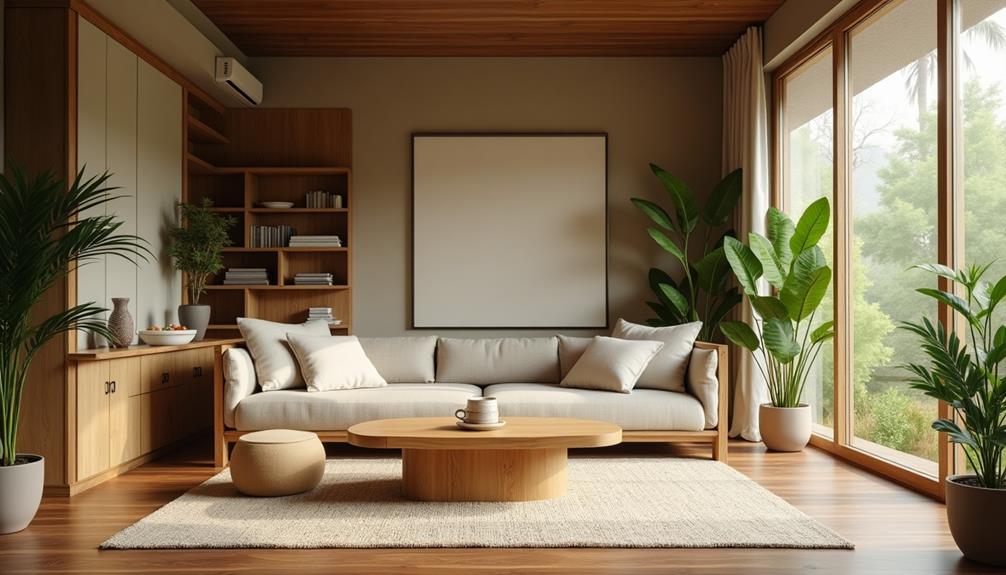
Affordable Small Space Solutions
How can you make the most of a small space without breaking the bank? Embrace affordable small space solutions that maximize your environment while keeping it stylish.
Multi-functional furniture is a game changer; think about a coffee table that doubles as storage or a sofa bed. This versatility allows you to utilize every inch of your small space effectively. Incorporating elements like Indonesian decorative pillows can add vibrant colors and intricate patterns, enhancing both comfort and cultural richness in your living space.
Incorporating minimalist decor is key to achieving an uncluttered look. Stick to essential elements and a neutral color palette, which helps maintain a serene atmosphere.
You can create a focal point in your room with a striking piece of art or a unique plant, drawing the eye and adding character.
Using local materials not only enhances aesthetic appeal but also supports sustainability, keeping costs down. An open layout encourages airflow and natural light, making your space feel larger and more inviting.
Tropical Design Inspirations
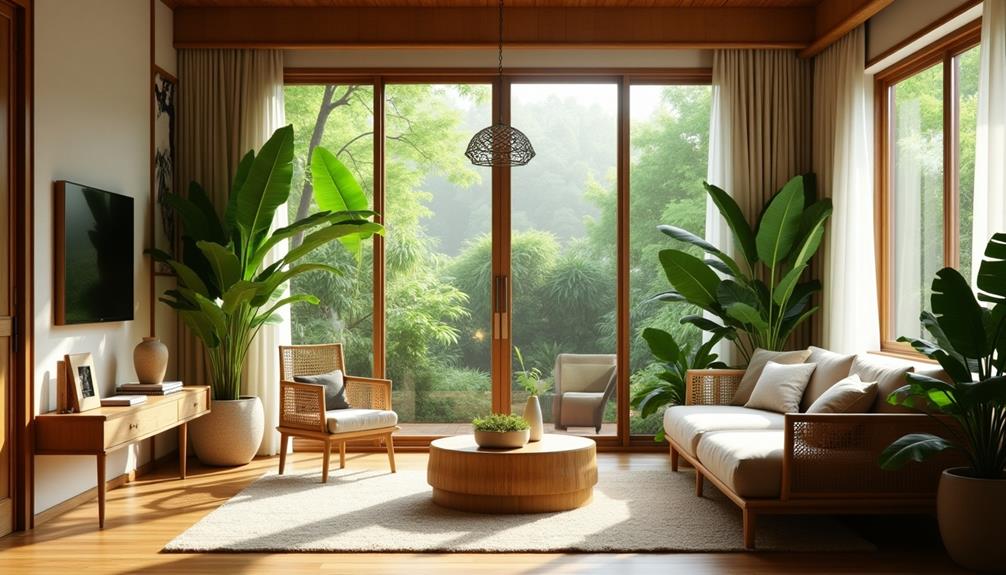
Embracing tropical design inspirations can transform your small space into a vibrant oasis that feels both spacious and inviting. In your living room, make sure to emphasize open layouts and natural light. This connection to the outdoors creates an airy atmosphere that combats feelings of confinement. You can achieve this by using large windows or sliding doors that blend indoor and outdoor spaces, enhancing the overall tropical living experience.
Utilizing local materials and craftsmanship not only enhances aesthetic appeal but also promotes sustainability. Consider incorporating multi-functional furniture that maximizes limited space while maintaining comfort and style. Think about a coffee table that doubles as storage or a sofa that converts into a bed.
Natural ventilation is essential in tropical designs, so aim for cross-ventilation methods that keep your environment cool and fresh.
Bright color schemes paired with the concept of minimalist decor can elevate your space further. Choose light shades that reflect sunlight and create a cheerful ambiance.
Cultural Influences in Architecture

Incorporating cultural influences in architecture can greatly enhance the aesthetic and functional qualities of your small space. Indonesian architecture beautifully reflects its rich heritage through traditional motifs and locally sourced materials, often seen in traditional Indonesian housing. By integrating these elements, you create a unique atmosphere that tells a story of artistry and culture.
Open layouts are a hallmark of Indonesian house design, maximizing natural ventilation and light—essential in a tropical climate. You can adopt this approach in your small space by opting for fewer walls and more windows, allowing fresh air and sunlight to flow freely.
Additionally, consider raised structures, which aren't only practical for flood protection but also add character to your design.
To foster a sense of community, think about incorporating communal spaces inspired by Indonesian architecture. These areas encourage social interaction, aligning with cultural values that celebrate togetherness.
Ultimately, prioritize sustainable building practices by using local materials, promoting eco-friendliness and a connection to the landscape. By embracing these cultural influences, your small space will embody both functionality and a deep appreciation for Indonesian traditions.
Functional Minimalist Furniture
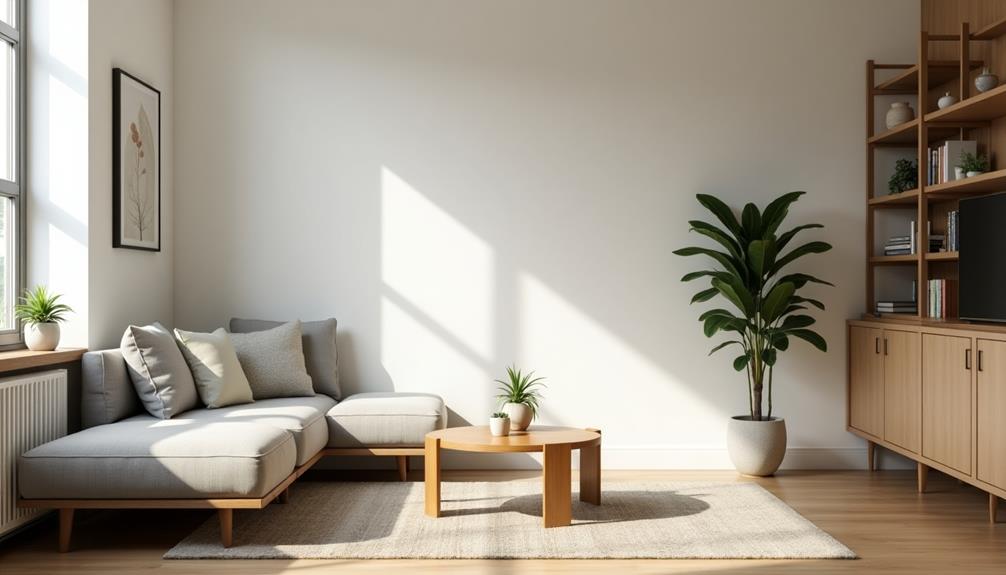
When you're making the most of a small space, functional minimalist furniture can be a game changer.
Incorporating traditional Indonesian style home decor can enhance your minimalist approach by utilizing natural materials that promote a sense of tranquility.
You'll appreciate multi-functional solutions that save space while adding a simple aesthetic appeal to your home.
Plus, clever storage options keep everything organized without cluttering your living area.
Multi-Functional Furniture Solutions
Maximizing space in small homes often hinges on the clever use of multi-functional furniture. In minimalist Indonesian design, you'll find pieces that serve dual purposes, like a sofa that effortlessly converts into a bed. This not only enhances utility but also keeps your living area adaptable.
For instance, luxury tropical design aesthetics often incorporate innovative furniture solutions that blend style with practicality.
Modular furniture systems are another excellent choice, allowing you to reconfigure your space easily to suit your needs. You can create flexible arrangements that optimize every inch of your home.
Additionally, consider storage ottomans and benches, which provide both seating and hidden storage solutions, helping you minimize clutter effectively.
Dining tables that extend or fold away are staples in small Indonesian homes, enabling you to enjoy meals and entertain guests without sacrificing valuable floor space.
Compact desks designed for multifunctional use, such as those that double as vanity tables, reflect the practicality and aesthetic of minimalist design, giving you a stylish workspace without the bulk.
Space-Saving Storage Options
Finding effective space-saving storage options is essential for maintaining an organized and stylish home, especially in small Indonesian spaces. Functional minimalist furniture is your best ally in this endeavor. Look for pieces that incorporate built-in storage solutions, like ottomans with hidden compartments or coffee tables featuring shelving.
These clever designs maximize your space efficiency and keep your living area tidy. To enhance your decor, consider incorporating vibrant Indonesian decor masks that not only serve as artistic elements but also provide additional storage when designed with shelves.
Consider multi-functional furniture pieces, such as sofa beds or dining tables that can double as workspaces. They not only reduce clutter but also enhance versatility, making your small space more dynamic.
Emphasizing local materials, Indonesian design often utilizes bamboo or reclaimed wood to create stylish yet functional storage options. This approach aligns perfectly with sustainable living practices, allowing you to contribute to the environment while maintaining aesthetics.
Don't forget about vertical space—wall-mounted shelves and hanging storage solutions help keep the floor clear, maintaining an open feel in your home. Minimalist furniture typically features sleek, clean lines and neutral color palettes, letting storage pieces blend seamlessly into the overall design while providing essential functionality.
With these ideas, you can effectively organize your small space without sacrificing style.
Simple Aesthetic Appeal
Simplicity in design often leads to stunning aesthetic appeal, especially in functional minimalist furniture. In Indonesian design, you'll find that pieces emphasize clean lines and geometric forms, enhancing space efficiency in small areas. This minimalist approach not only looks elegant but also maximizes your living space.
Incorporating elements of tropical-themed luxury interior design, these pieces often utilize local materials like bamboo and teak, promoting sustainability while adding a natural touch that resonates with tropical living.
You'll notice that multi-functional furniture, such as sofas that convert into beds or coffee tables with hidden storage, plays a vital role in maintaining both utility and style in compact environments.
Light and airy designs, often featuring bright colors and neutral palettes, help create a sense of spaciousness, making your interiors feel more open and inviting.
Each piece is crafted with care, ensuring that it serves a practical purpose while contributing to the overall aesthetic harmony of your space. By choosing functional minimalist furniture, you not only enhance your home's visual appeal but also embrace a lifestyle that values simplicity and efficiency.
Bright and Airy Color Schemes
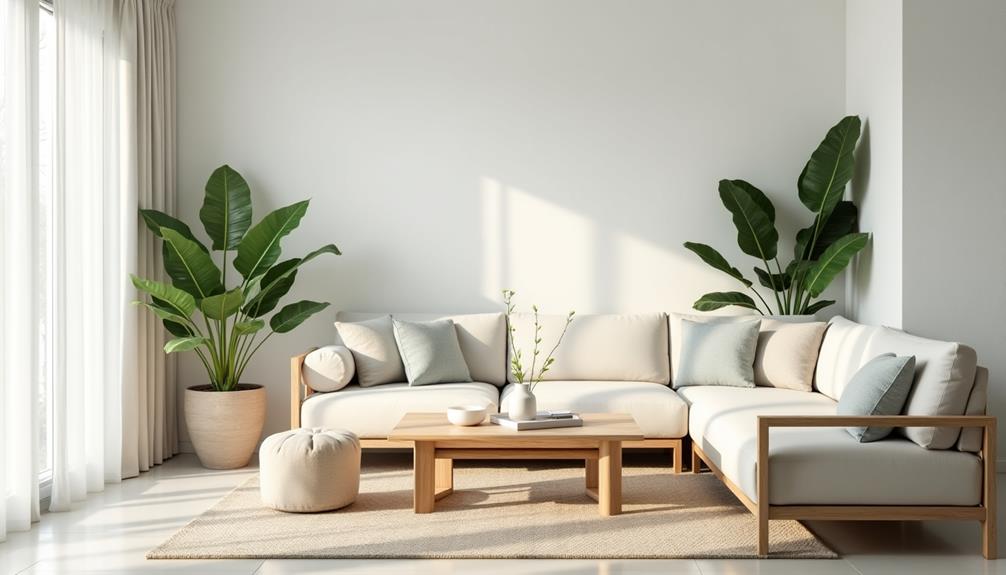
A bright and airy color scheme can transform small Indonesian spaces into inviting retreats. Using shades like white creates a sense of spaciousness, making your area feel larger and more open. Light colors reflect natural light, enhancing brightness and contributing to a clean, airy atmosphere essential for minimalist design.
This approach aligns with the principles of modern tropical aesthetics in Bali, which emphasize blending indoor and outdoor environments through bright, open spaces.
To elevate the elegance of your small space, consider matching floor and ceiling materials in light hues. This continuity not only enhances the aesthetic but also ties the design together, making everything feel harmonious.
The psychological effects of bright colors can greatly reduce feelings of confinement, creating a more welcoming and comfortable environment for you and your guests.
You can incorporate bright accents through decor elements, adding vibrancy without overwhelming the minimalist aesthetic. Think about colorful cushions, artwork, or decorative plants that pop against a neutral backdrop.
These touches maintain a balance between beauty and functionality, ensuring your space feels lively yet uncluttered.
Maximizing Space With Integrated Areas
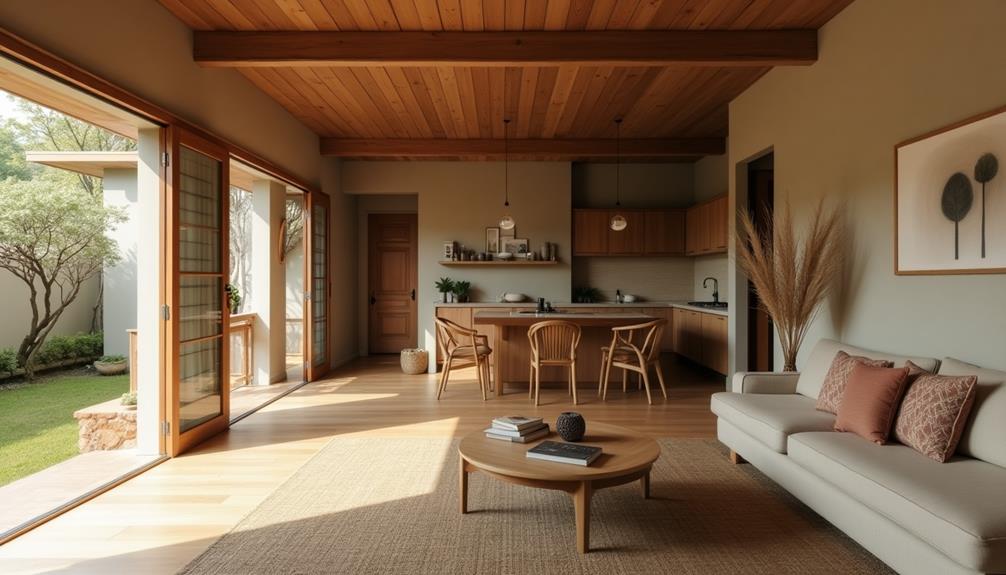
Combining your living and dining areas can transform your small space into a more functional and inviting environment.
An open-concept layout not only maximizes square footage but also encourages social interaction among family and friends.
By incorporating unique decor pieces such as a Face Indonesian Decor Mask to your walls, you can infuse cultural richness into your home.
Combining Living and Dining
In a cozy apartment, merging the living and dining areas can transform your space into a vibrant hub for social gatherings and everyday relaxation. This combination creates a multifunctional environment that encourages social interaction while maximizing your available square footage.
To enhance comfort and functionality, consider using furniture that serves dual purposes. Ottomans, for example, can provide seating and storage, helping you keep the area tidy.
An open layout with minimal barriers allows natural light to flow freely, making your small space feel larger and more inviting.
By selecting a cohesive color palette and design elements for both areas, you'll create a harmonious atmosphere that visually expands your space.
Strategically placing furniture can define functional zones within your combined living and dining area, ensuring you don't compromise on comfort or accessibility.
With thoughtful planning, you can enjoy a lively, integrated space that feels both welcoming and efficient.
Embrace minimalist Indonesian design ideas to create a chic, clutter-free environment that meets your lifestyle needs while maximizing every inch of your cozy home.
Open-Concept Layout Benefits
Embracing an open-concept layout can greatly enhance your small space, allowing for a seamless flow between the living, dining, and kitchen areas. By eliminating walls, you maximize the perception of space, making your home feel larger and airier. This integration provides several benefits that can transform your living experience.
- Enhanced Social Interaction: Combining multifunctional spaces encourages engagement, making it easier for families and guests to connect.
- Optimized Natural Light: Large windows and minimal barriers flood your space with light, improving the overall ambiance and creating an inviting atmosphere.
- Flexible Furniture Arrangements: You can easily adapt your layout for various activities, giving you the freedom to rearrange without feeling confined.
Open-concept designs foster a sense of togetherness, ideal for small families or gatherings.
You'll appreciate how the integrated spaces enhance connectivity among occupants, making every moment spent at home more enjoyable.
Whether you're hosting a dinner party or enjoying a quiet evening, this layout supports a dynamic, multifunctional lifestyle that suits your needs perfectly.
Natural Materials for Serenity
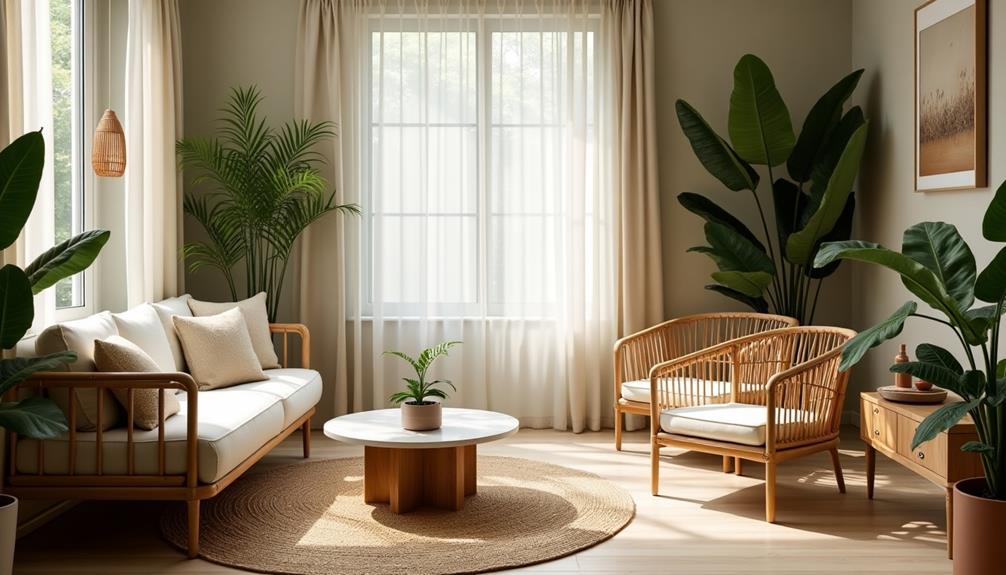
Natural materials play an essential role in creating serene spaces inspired by minimalist Indonesian design. By incorporating elements like bamboo, teak, and rattan, you not only enhance the aesthetic appeal of your space but also promote sustainability. These materials are eco-friendly, allowing you to create a tranquil environment that respects nature.
Utilizing local stone and wood in your construction helps blend indoor and outdoor areas seamlessly, fostering a harmonious connection with the natural surroundings. Textiles made from natural fibers like jute and sisal add warmth and texture, ensuring your minimalist interiors remain inviting without feeling cluttered.
Maximizing natural light through large windows and open spaces further enhances the calming atmosphere. The interplay between light and natural materials creates a soothing backdrop for relaxation.
Additionally, embracing traditional Indonesian craftsmanship through handmade furniture and decor pieces brings cultural heritage into your home while maintaining functional simplicity.
Frequently Asked Questions
What Are the Key Principles of Minimalist Indonesian Design?
When exploring minimalist Indonesian design, focus on simplicity, functionality, and natural materials. You'll appreciate clean lines, earthy tones, and open spaces that create a serene atmosphere, allowing you to connect with nature and foster tranquility.
How Can I Incorporate Traditional Indonesian Motifs Subtly?
To incorporate traditional Indonesian motifs subtly, you can use patterned textiles or decorative accessories. Choose items with muted colors, and blend them with modern furnishings to create a cohesive, minimalist look that honors cultural heritage.
What Colors Promote a Serene Atmosphere in Small Spaces?
Studies show that 70% of people feel calmer in spaces with soft blues and greens. To create a serene atmosphere, you'll want to incorporate these colors into your design, balancing them with neutral tones for harmony.
How Do I Choose Multifunctional Furniture for My Small Space?
When choosing multifunctional furniture for your small space, look for pieces that serve dual purposes, like a sofa bed or storage ottoman. Prioritize compact designs that maximize utility while keeping your environment open and inviting.
What Natural Materials Are Best for a Minimalist Indonesian Aesthetic?
Did you know that over 50% of homeowners prefer natural materials for their interiors? For a minimalist Indonesian aesthetic, consider bamboo, teak, and rattan. They're durable, sustainable, and effortlessly enhance your space's warmth and style.
Conclusion
Incorporating minimalist Indonesian design ideas into your small space can create a stunning sanctuary. By blending bright colors with functional furnishings, you'll foster a fresh, flowing atmosphere. Embrace tropical textures and cultural cues for a cozy, enchanting vibe. Remember, it's all about maximizing your mini haven with clever concepts, ensuring every corner counts. With these design tips, you're on your way to a beautifully balanced and blissful abode that radiates simplicity and serenity.
